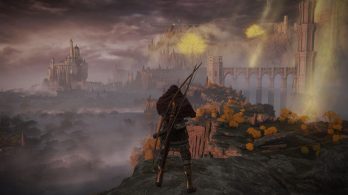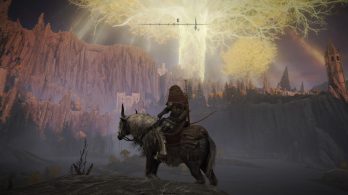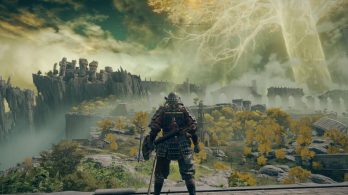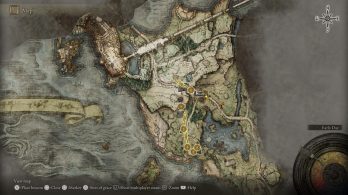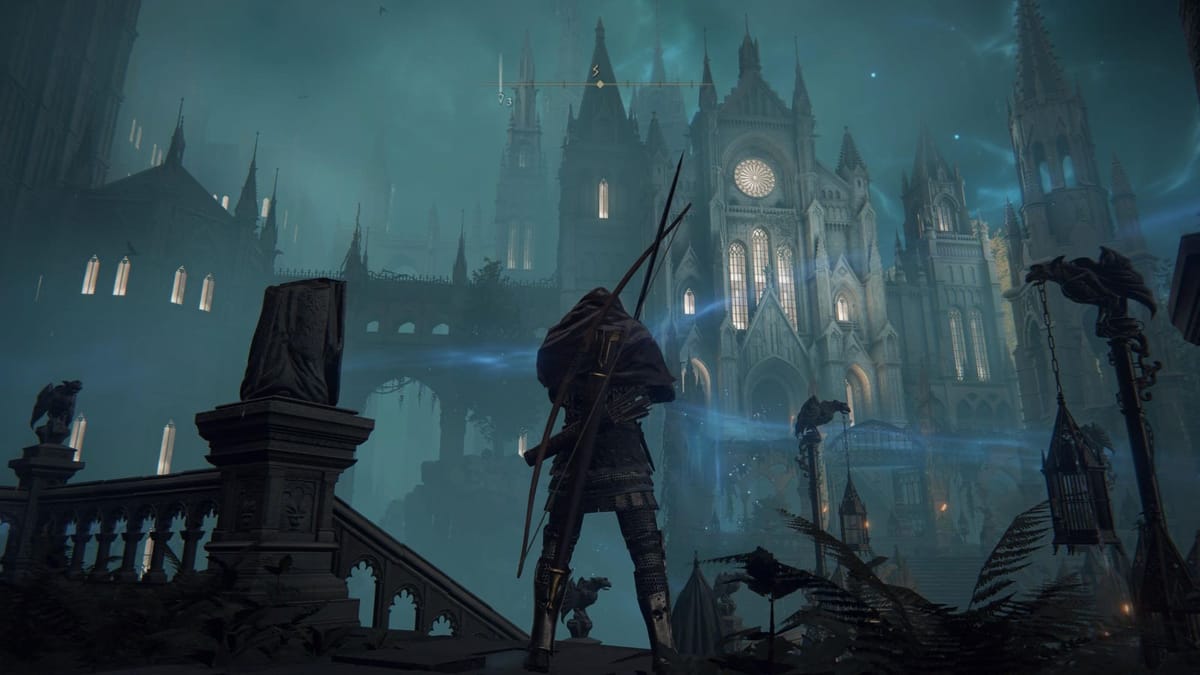
I’ll admit that I was skeptical the first time that I heard a Souls game was going open world. While, yes, previous entries did (mostly) allow you to explore at will, they still had a somewhat defined “correct” path of progression which you normally found by stumbling into an area and immediately dying if you hadn’t yet built your character up enough to survive. You then rinse and repeat until you’ve made progress via tiny increments.
To my surprise Elden Ring, despite its large open world, still functions essentially the same. Each large area of the map seems tailored to what the developers assume the average player’s level will be upon reaching that area. There are basic enemies which, while hard and can still overwhelm quickly in large numbers, are relatively simple to take down with patience, along with a smattering of much harder enemies that may take players a few hours of leveling up to overcome. Thankfully, due to the open world design, players can easily sneak past most tough enemies and come back once better prepared.
Each area is also densely populated with a large roster of unique boss battles, most of which are found off the beaten path and provide various important items, including those which can be used to upgrade your armaments, add new Skills, and more. Occasionally you’ll encounter a “main” boss, which typically has a short cut scene and features a much more in-depth battle than the optional bosses. Technically, you can run straight to these bosses and avoid exploring the open world all together, but you’d be hard pressed to succeed without coming in prepared with at least a few Skills to experiment with, a decently high level, and better equipment than your base items. While there are large open world segments, there are also the claustrophobic dungeon areas we’ve come to expect from a Souls game, which helps break up the gameplay. This level of freedom has never been seen in a Souls game before and thankfully, it works (mostly).
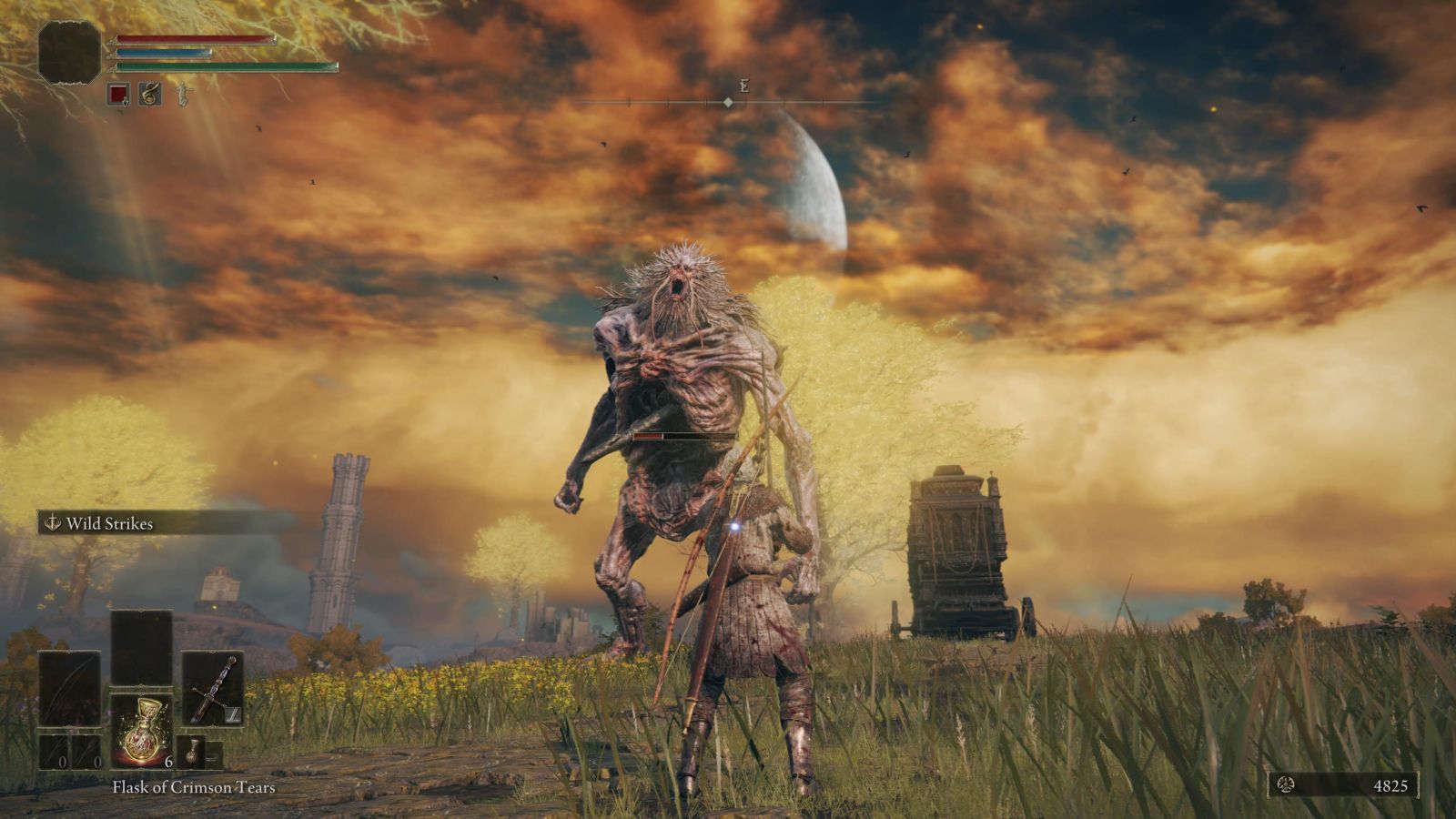
Story:
The Elden Ring has been shattered and Queen Marika the Eternal is missing. Marika’s demigod offspring have all claimed the shards of the Elden Ring, which triggered the Shattering: a devastating event which has left The Lands Between in a state of despair. A war occurred, but with no clear victor. Then came you, once deceased, but now given new life as a Tarnished – a seeker of the Elden Ring and one who hopes to become the Elden Lord.
As per usual, you will learn the story mainly through exploration. There are few cutscenes to speak of, save from a few boss introductions, otherwise you’ll learn via reading descriptions of in-game items and through visual cues provided by the areas you explore. While some may not enjoy this form of storytelling, I’ve always loved finding the lore hidden throughout the world and piecing together the backstories of those enemies I encounter. Elden Ring’s story is no different and still remains satisfying to unravel.
The normally cryptic dialogue feels much more character focused now: each NPC you encounter has some sort of story you can choose to engage in, or kill them on the spot if you want some quick items. It doesn’t betray the storytelling style FromSoftware is known for, but rather explores an interesting new approach.
Gameplay Basics
Elden Ring is a souls game through and through, and features all the same mechanics you’re used to. After a brief opening area where you learn the basics of combat, you are thrust into the open world and left to fend for yourself. Immediately you’ll find a site of grace, Elden Ring’s version of the Dark Souls bonfire. Resting at a site of grace will restore your HP, FP, and cleanse you of any ailments along with refilling your flasks (Red and Blue for HP and FP). Like previous Souls entries, resting will also respawn most enemies. While resting at a site of grace you can pass time, memorize spells, level up, sort your chest, organize your flasks, equip ashes of war, and more. Most importantly, sites of grace on the critical path have a light which will guide you in the direction you need to go to progress.
Organizing your flasks allows you to allocate how many flasks restore HP or FP, while Golden Seeds you find during exploration will create new flasks and Sacred Tears will upgrade the amount restored by each flask. Ashes of War are the most unique aspect of Elden Ring, as they allow you to equip skills to your weapons which consume FP to perform. These skills are extremely powerful and change based on the weapon type. Early on Skills will absolutely help you overcome multiple bosses, and continue to remain vital throughout your playthrough.
Early on you’ll be introduced to Melina, a Finger Maiden who will allow you to level up in exchange for runes, which you obtain by defeating enemies. Melina can be spoken to at any site of grace, allowing you to level up no matter which site of grace you stumble upon. Melina also provides you with the Spectral Steed Whistle which summons Torrent, your spirit horse – who is an absolute necessity when traversing The Lands Between.
Speaking of traveling, sites of grace can be used as fast travel points, and with the extremely quick load times on both PC and PS5, this feature makes exploring The Lands Between a much less daunting experience. Simply selecting a site of grace from the map will transport you there within seconds and for areas far from a site of grace there are Stakes of Marika , typically near bosses, which allow you to revive at those upon death instead. This, coupled with the ability to set light beacons on the map to mark areas of interest you’ll want to visit later, makes this one of the easiest Souls games to navigate, despite the sometimes confusing world.
Map fragments can be found which will fill in details on the overworld map, giving you a better idea of where structures are located. You are able to purchase a crafting kit early on which allows you to collect resources from the world to craft a variety of items, most important of which are arrows. Vendors often sell new cookbook recipes which allow you to create additional items upon purchasing.
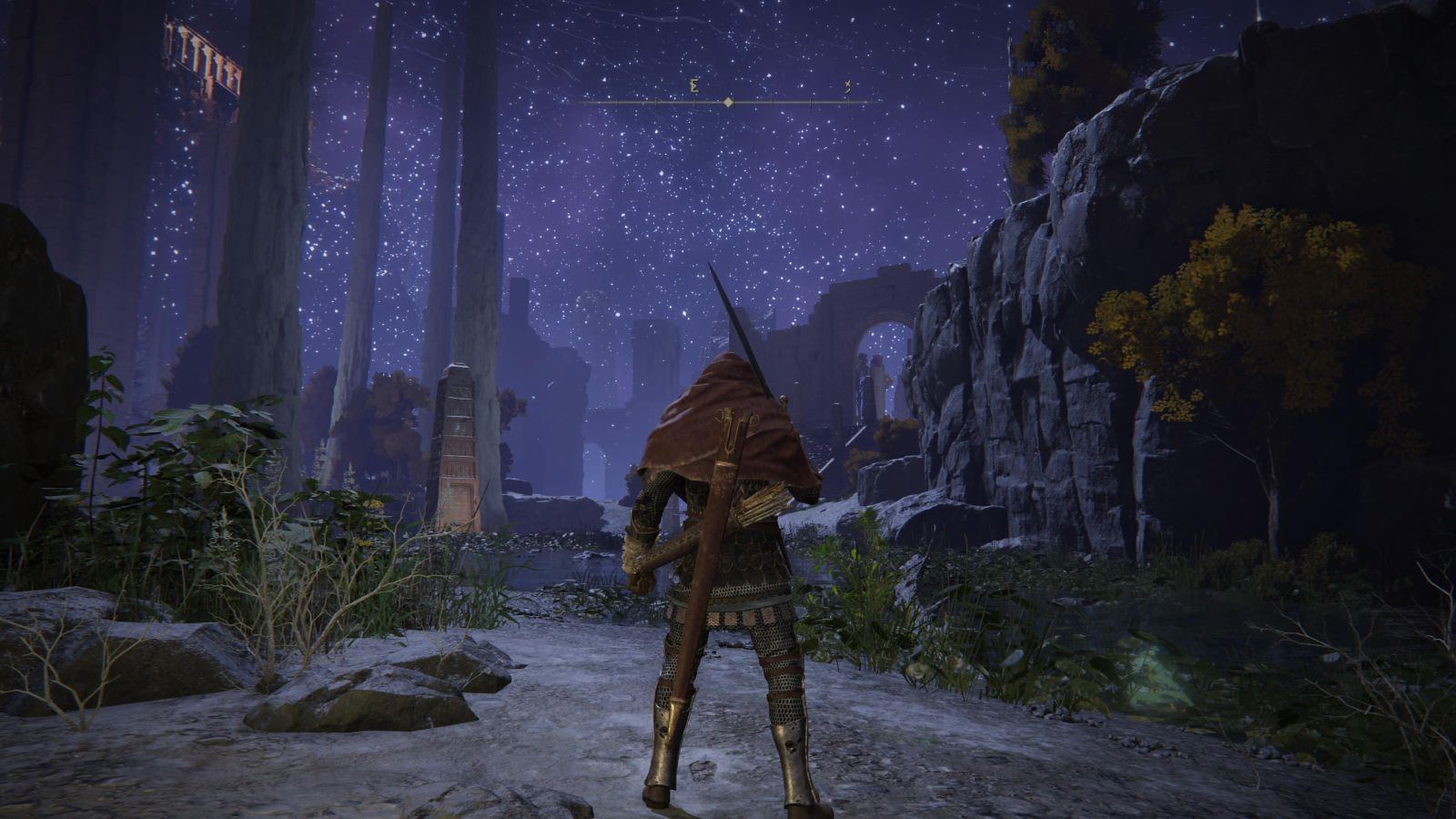
Getting Started:
Elden Ring provides the most robust character creation system to date, with the ability to alter skin color, voice, age, and nearly every aspect of your character’s face, hair, and body. Coupled with 10 base templates, including warrior, aristocrat, truth-seeker, northerner, draconian, nightfolk, numen, seafarer, and reedlander, along with nine starting classes including warrior, wretch, prisoner, samurai, prophet, vagabond, hero, bandit, astrologer, and confessor, each with their own unique abilities, stats, and starting weapons and armor. You’re also given your choice of a keepsake, including items which raise your starting HP, can be used to add another flask to your inventory, or even unlock secret areas.
Multiplayer Basics:
Elden Ring’s take on multiplayer is unique to the Souls series, but still functions essentially the same, although you must use a variety of items to fully participate including the Tarnished’s Furled Finger, Furcalling Finger Remedy, White and Blue Cipher Rings, Festering Bloody Finger, and the Duelist’s Furled Finger.
You will not see summon signs without first using the Furlcalling Finger Remedy, which can be purchased or crafted. By using this item, you’ll see signs of both allies and adversaries. Gold signs are for allies who will join your match until you defeat a boss, while red signs indicate adversaries who will come into your game to duel.
To help other players, you can use the Tarnished’s Furled Finger to place a gold sign which will allow players to call you into their game. When summoned, you are known as the Furled Finger and the summoner is known as the Host of Fingers. You can use the Duelist’s Furled Finger to leave a red summon sign and challenge other players to a duel.
You can place signs nearly anywhere in the game, but most signs you will find near a site of grace or summoning pools, which serve as a collective area for players to easily find cooperators and duelists. Summoning pools must be activated by examining statues, usually nearby a site of grace. There is an item which can be used to send your summoning sign to multiple summoning pools in your general area, helping you find a variety of players to co-op with.
The Festering Bloody Finger is used to invade another player’s world in hopes of defeating them. The White Cipher Ring, when in use, will call for a hunter from another world to aid you when yours is invaded, while the Blue Cipher Ring allows you to be called to the aid of another hunter.
Despite having to use an item before seeing any signs and the new summoning pool aspect, multiplayer is almost exactly like previous Souls entries. For those who do not play online but would still like help occasionally, there are NPCs you can find who will then aid you during specific boss fights.
Richard’s Impressions:
It’s no secret that I’m a huge Souls fan, so I’ve been waiting for Elden Ring for years and can safely say that it has lived up to my expectations. Sure, I have a few gripes with the open world aspect, but I also applaud FromSoftware for taking risks with the Souls formula and creating their most diverse gaming world yet. For those afraid that this entry may be easy, you can quit worrying – you’re still going to die, a lot. While yes, some bosses and enemies feel easier than past Souls games, there are still quite a few ridiculously hard areas you’ll traverse and bosses you’ll encounter, especially late game. In reality, the only reason parts of the game feel easier is just because there’s so many bosses and areas with such a wide variety of encounters that every playstyle will run into a mixture of difficulties depending on their build and skill set.
Elden Ring awards runes for defeating enemies, rather than souls. Leveling up takes far longer in this entry than in previous Souls games, ensuring that despite having a ton of bosses and enemy packs to encounter, you won’t be able to overpower the enemies by becoming too strong too early. This means you’ll have to pick your stats wisely, as you’ll need to perfect your playstyle to make it through all the encounters you’ll face. If you begin to feel you’re becoming overpowered, don’t worry – you will inevitably hit a brick wall of difficulty as you progress, no matter how much you’ve leveled up in preparation.
That brick wall of difficulty is one of my only gripes with Elden Ring. Don’t get me wrong, I come into these games expecting a challenge, but Elden Ring is the first time that I felt a few of the bosses, including one of the “main” bosses, actually felt unfair due to their ability to one-shot kill you despite your level and stats, and their sporadic moveset which made them nearly impossible to predict. While sure, I know there are a few people out there who will breeze through even the toughest fights, I feel most will become frustrated. Thankfully, co-op makes most of these fights easier as you can use a summoned player to help distract a boss, but this time around it almost feels as if the game was created with co-op in mind – which is sure to upset a few people who believe solo is the only way to play the series. That said, even with co-op that “main” boss I mentioned above was still frustratingly difficult and took out my summons with one hit as well before I felt like I essentially just got lucky and beat him.
I don’t mind a Souls game being created around the idea of playing co-op, in fact, co-op is my favorite thing about the Souls series. But early on when there weren’t many players that had reached my level it made a few of the fights incredibly frustrating. Now that the community has flourished and can be found nearly everywhere in The Lands Between, this frustration has mostly been alleviated.
The open world is a breath of fresh air for the series, and provides you with nearly unlimited freedom from your first minutes with the game. Sites of grace will feature a guiding light you can follow to your main objective, but the game world was created to be explored. In fact, not exploring will almost certainly result in you failing to defeat any of the game’s “main” bosses. The world is filled to the brim with locations to discover, ruins to scour, enemies to take down, optional bosses to fight, and caves to explore.
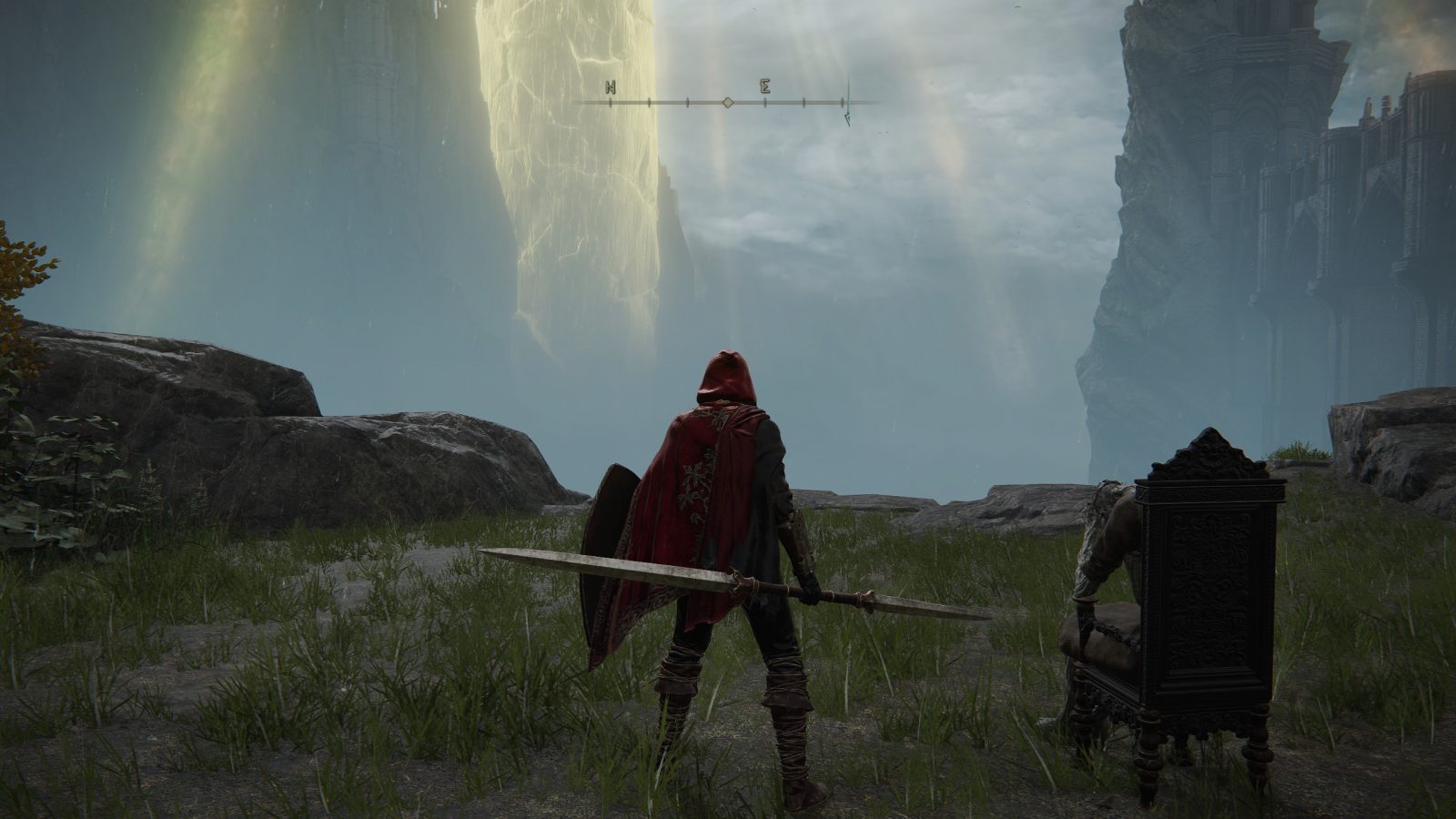
That sheer freedom of exploration, while amazing, is actually a hindrance to the game at times, as there is almost too much to discover with next to no help in finding these optional locations. You can easily ride right past a door and miss a whole cave and boss, not to mention weapons or ashes of war. While I loved stumbling upon new locations, as more and more of the map opened up I became overwhelmed with keeping track of where I’ve been and where I still needed to explore. The developers do seem to recognize this, and thanks to the new beacon system, I was able to leave beacons on the map for any area that I needed to come back to once I felt leveled up enough to handle the boss or enemies there. That minor gripe aside, the core gameplay is nearly perfect and even when overwhelmed with options and areas to explore, I still had a blast. As the internet scours every nook and cranny and makes detailed lists of bosses and items, this issue will disappear altogether, as you’ll no longer have to worry about whether or not you missed an item or area.
While the focus of any Elden Ring coverage seems to be the open world, that’s just a small part of the overall experience, essentially functioning as an area to explore and level up before progressing the story, which normally involves exploring a variety of dark and dangerous manors, dungeons, and more which all would feel at home in any Dark Souls title, particularly Dark Souls 3. These locations are beautifully detailed, containing an impressive variety of gruesome and difficult foes, and normally house much more threatening bosses. The freedom of the open world contrasts nicely with the claustrophobic indoor areas to create the most varied Souls experience yet. Seriously, no matter how many hours I poured into this game I continued to be amazed by the sheer variety of locations, the creativity of the enemies, and the fact that at 60 hours in I was still finding new areas to explore.
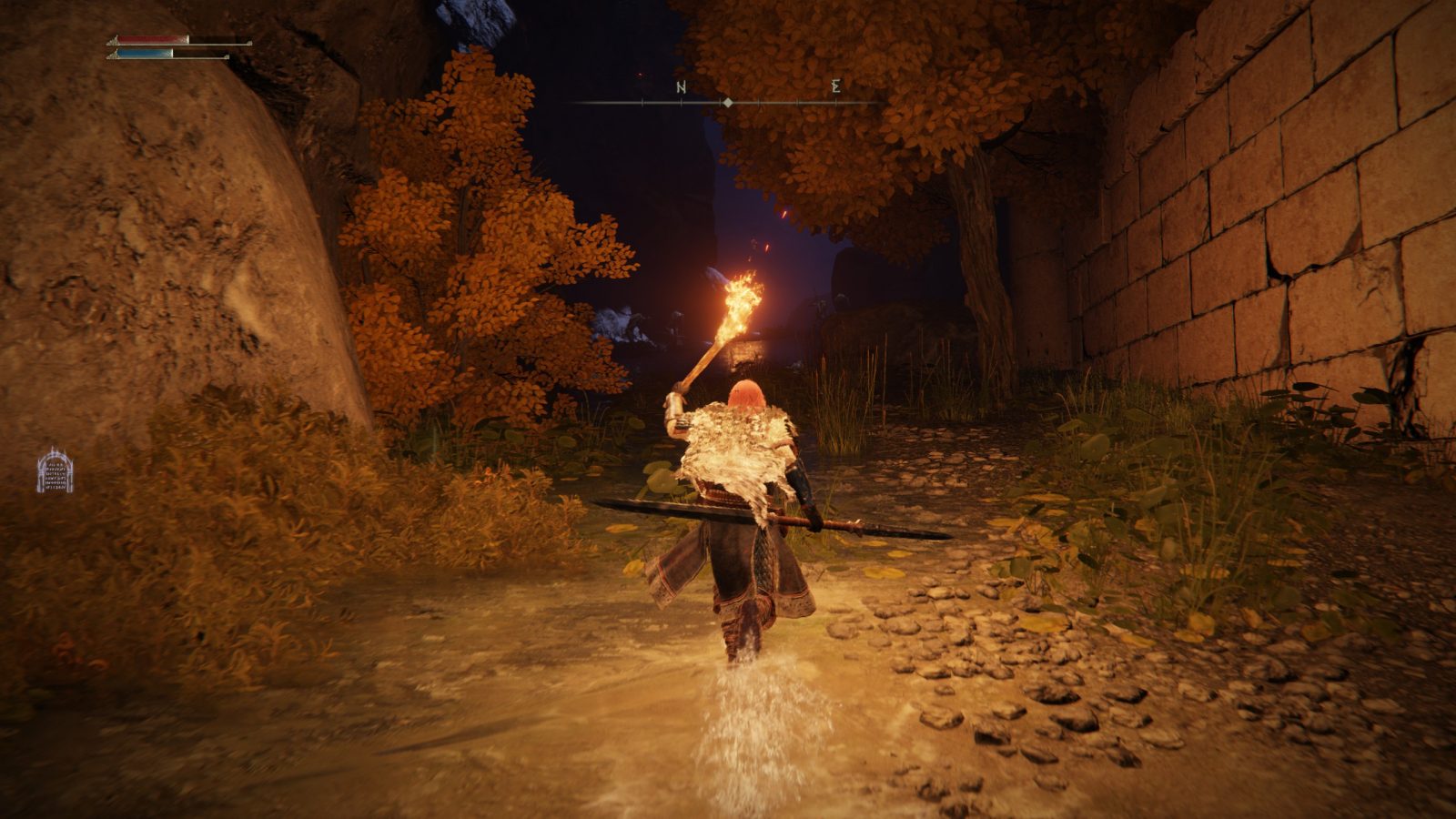
Along with the open world is a new focus on crafting, which has players collecting bushes and even bones from animals to create anything from arrows to explosive pots. The amount of items you can craft grows as you progress through the campaign, either by finding cookbook pages or purchasing new pages off of merchants. While I didn’t mess with the crafting often, aside from making sure I always had a full quiver of arrows, it is a nice addition that I’m sure many players will enjoy.
Unlike the other editor who played on PC, I found next to no issues on the PS5. Load time is near instantaneous and the graphics are downright gorgeous. I found myself constantly snapping pictures of the locations, enemies, and bosses I encountered as the game constantly ups itself with creativity in both location and enemy design. I only encountered slowdown once, and it was random – I think it was actually related to my internet messing up rather than the game because it quickly resolved itself. This fast loading extends to summoning, with Elden Rings boasting the fastest summoning process in any Souls game. It’s incredible to enter an area, see a summoning sign, and have a player at your side in mere seconds – this definitely helps make Elden Ring a more accessible entry and new areas less stressful to explore.

This was originally a review in progress, as to me, the Souls games are a shared experience, and to be missing that aspect hurts the overall experience. During the original review timeframe there was next to zero co-op available, due to the limited number of players available. Now that the game has been out for a few days that has changed, and the community is in full swing, providing the online experience I expect from the series. The online experience has been wonderful, and I’ve thankfully encountered little issue with summoning or being summoned. The messages left by players are hilarious, informative, and still dangerous to follow blindly as many are hoping to lead you to an early death.
I can easily say that this is my favorite Souls experience. Simultaneously unique and familiar, the beautiful landscape, incredible enemy and boss design, sheer variety of weapons and builds available, and the introduction of crafting and weapon skills all converge to create my favorite gameplay experience in years, and one I look forward to mastering throughout the next few months.
David’s Impressions:
To be completely honest, I’ve been getting very tired of the Souls formula. I skipped Sekiro and while I have dabbled in the Demon’s Souls remake, it largely feels like I have been there done that three or four times before. That being said, I was extremely excited for Elden Ring and it’s shaking up of tried and true gameplay styles. Having put over 20 hours into the game so far, and having only defeated 2 demigods, I can safely say that this was a change well worth the wait. It does have a few issues that have been creeping into FromSoftware’s design since at least Dark Souls 2, but the more open ended approach feels like a revelation.
I started off with the Astrologian class as I like to have a mix of melee and magic. While the former feels about the same as ever, with slow, methodical animations, magic actually feels a lot better now. For starters, you have combos which use both your FP and Stamina to rapidly cast the same spell. Early on, this speed allows magic to feel overpowered, but quickly most foes gain a lot of resistance to magic so only the most dedicated of spellcasters can fully rely on it.
While you are directed by the grace light towards Stormveil castle and the first Shardbearer, the game fully expects you to explore most if not all of the open world before even going in that direction. There is certainly a lot to see and do, but the lack of direction can occasionally grind progression to a halt. Exploration in and of itself is an absolute joy – you can ride past encounters you don’t feel prepared for and engage with those that you do in any way you see fit. There are bosses to slay, caves and dungeons to delve into, and even secret teleports to take you across the entire map. The aforementioned caves and dungeons are probably my favorite part because a lot of them offer a streamlined microcosm of the larger, story critical dungeons. After entering, you’ll always find a site of grace to allow you to teleport back or respawn when you die, and sometimes you’ll even see the boss door directly in front of you. The rest of the dungeon leads to a leaver to open said boss door, allowing you to retry the boss without going through the whole thing over and over. The level design here feels focused on convenience while still providing an interesting world to explore along with a mostly fair challenge.
Surprisingly, the most frustrating part is actually finding places of interest. Caves in particular blend into the shadows of cliff faces so I found myself walking past quite a few of them, leading me to wander around searching for places to get new items and level my character up for the next challenge in the story. Wandering can be fun in and of itself, but sometimes you just want to progress and you can’t find a single level 2 smithing shard to upgrade your weapon to the next tier even though you have plenty of level 3 and beyond shards. Just a bit more direction would be appreciated, while still having exploration as the focus. There are a few spirits you can find who will slowly guide you to a dungeon, but those are few and far between.
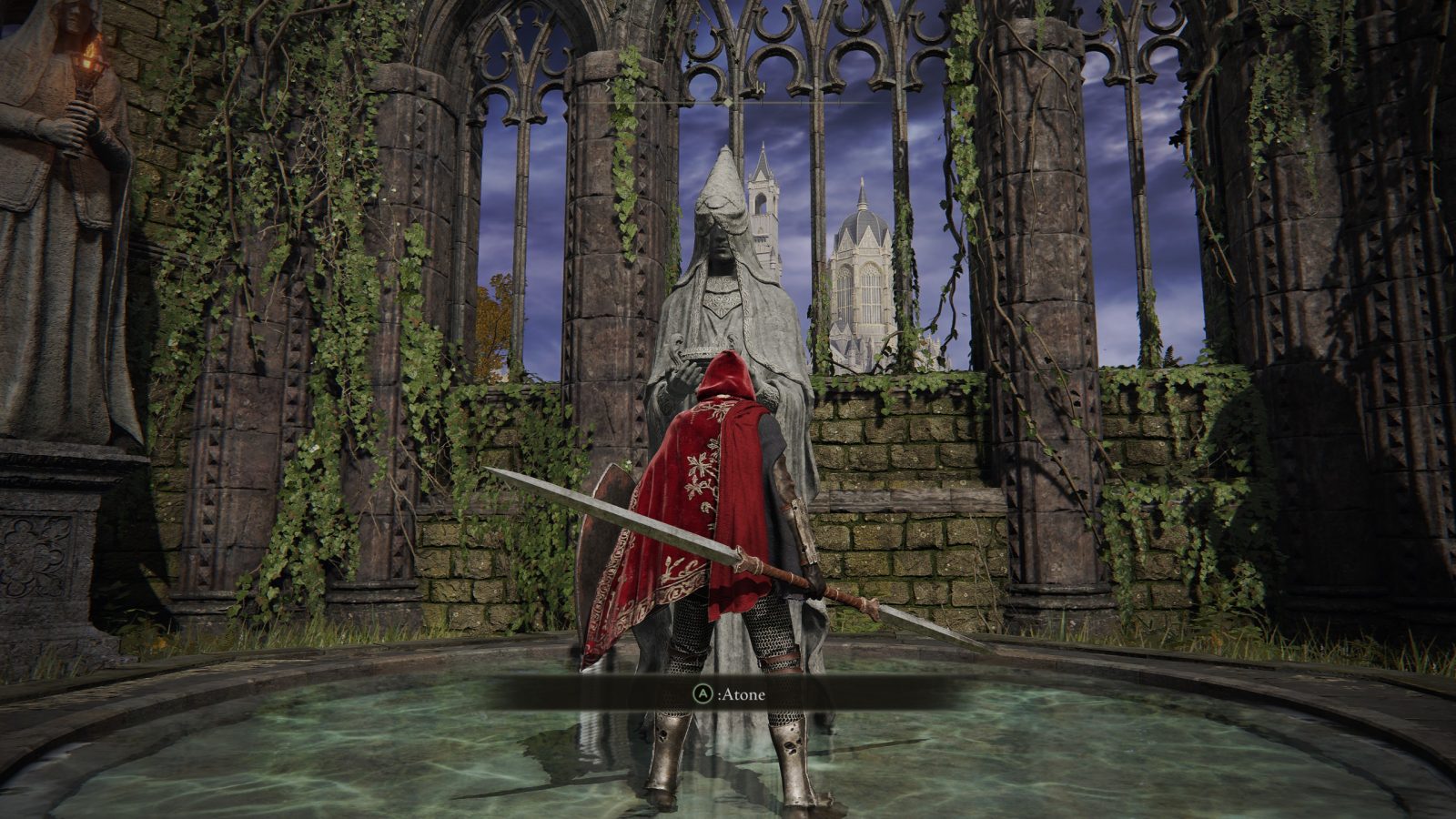
When I say the game is mostly fair, I’m talking about THOSE enemies who seem to be able to kill you effortlessly even if you do everything right. You know the ones I’m talking about: the knight whose powerful overhead strike magnetizes to you, the ghost that just spawns in after you pass by even though you made sure to check the corner, and of course that one boss who will occasionally just one hit kill you for no reason. Make no mistake, Elden Ring has more than its fair share of BS to go along with fights that actually feel fair and those that are way too easy. Granted, some of this may be due to the open world and being able to go wherever you want, but for quite a few leveling or even “getting good” doesn’t help, it’s pure luck.
I also hate to say it given how gorgeous the game is, but playing Elden Ring on PC might not be the best experience. You do have a very nice suite of options to work with, fully rebindable controls, the ability to seamlessly swap between keyboard and mouse, mouse cursor support for menus, and even some very nice HDR, but the game has a tendency to stutter or hang pretty frequently. I suspect this has something to do with shader caching because it mostly happens when entering a new area or fighting a new boss. The game also keeps running during these stutters because of its always online nature, so this can lead to some deaths you literally cannot avoid. I did eventually learn to deal with them, but it remains a frustration throughout the game and will hopefully be fixed in future patches along with the crashes they can cause. There’s also a strange issue where two lines of dialogue skip when you press A, and this even occurs when selecting a dialogue option.
After the initial two areas, the game feels intended for co-op play. That’s not to say you can’t play solo, but the odds feel more stacked against a lone adventurer than normal. Most normal enemies can take a lot of damage and deal even more, so unless you’re very patient either to grind or avoid attacks for a very long time, you’ll want to summon a few friends. Unfortunately, I still haven’t been able to do this several days after launch. You can summon spirits to help you in select locations, but a certain boss I’m stuck on doesn’t allow you to do so. I don’t know why I can’t summon people, the game just tells me it failed.
Elden Ring
Excellent
Elden Ring is the culmination of all the Souls entries up to this point, creating a near perfect gameplay experience filled to the brim with incredible boss fights, gorgeous graphics, and an insanely large world to explore. A variety of new ideas, including crafting and the addition of the spirit horse Torrent, help bring a new level of immersion to the proceedings while simultaneously helping Elden Ring feel like a unique entry in the Souls genre. With gameplay tailored for players who want to experience the world solo as well as those who wish to play nearly the entire game in co-op, Elden Ring is a masterclass in design. Minor gripes about a couple of boss fights and the sheer density of the world to explore leaving many areas potentially undiscovered aside, Elden Ring is a nearly flawless experience which old and new fans of the Souls series will enjoy.
Pros
- Incredibly large and diverse world to explore filled with optional bosses, weapons, skills, and secrets.
- New ideas, such as crafting and the horse, help the game feel fresh.
- Includes some of the most intense and creative boss fights in the Souls series.
Cons
- A few framerate issues on PC
- The world can be a bit too large and intimidating, especially for completionists.
- A couple of bosses feel unfair, or like they were made to be beaten with another player rather than solo.

